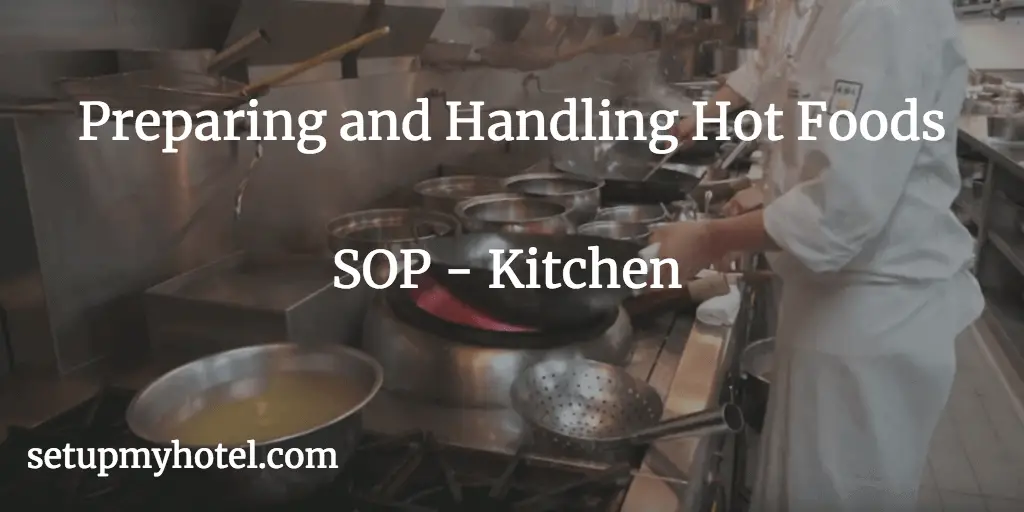Preparing and Handling Hot Foods in the Hotel Kitchen
Preparing and handling hot foods in a kitchen or F&B production setting requires strict adherence to standard operating procedures (SOPs). These procedures are designed to ensure the safety and quality of the food being served to customers.
Firstly, it is important to maintain proper hygiene and sanitation when handling hot foods. This includes wearing clean and appropriate protective clothing, such as gloves and hairnets, and frequently washing hands and equipment.
The temperatures of all cooked food should be taken during preparation to ensure the safety of all food served to the customer are safe and as per the standard practice.
Secondly, hot foods should be prepared and cooked at the appropriate temperatures to prevent the growth of harmful bacteria. This requires proper calibration of kitchen equipment, such as ovens and stovetops, and regular monitoring of food temperatures with a food thermometer.
Finally, proper storage and transportation of hot foods is essential to maintain their quality and safety. Foods should be stored in covered containers at the appropriate temperatures, and transported quickly to prevent bacterial growth.
By following these SOPs, kitchen and F&B production staff can ensure the safe and effective preparation and handling of hot foods, providing customers with delicious and high-quality meals.
The Executive Chef and the Sous Chef should be responsible for ensuring that the hot foods are prepared using appropriate practices and procedures to ensure safety and sanitation. The hotel management should develop and implement proper written Kitchen SOP’s to ensure the same is implemented correctly throughout all the food preparation outlets.
Hot Food Preparation Standard Procedures:
How to Cook Hot Foods in the Kitchen?
- Always avoid over-cooking the food prepared.
- Use a calibrated thermometer to check product temperature in the thickest part of the item or at least in two separate places.
- Always take end-point cooking temperatures.
- Try to reduce the holding time of foods before serving by using batch cooking.
- Allow the temperature of the cooking equipment to return to the required temperatures between batches.
- Do not use hot-holding equipment to cook or reheat foods.
- Expose food ingredients to room temperature for two hours or less, or food items should be returned to the refrigerator.
- The total time of any food at room temperature shall not exceed more than 4 hours.
- Prepare food products that will not be cooked or heated away from other products.
How to take the temperature of Hot Foods?
- Always wash and sanitize your hands.
- Use a clean and sanitized calibrated thermometer to take the temperatures of all cooked foods.
- Always wipe and sanitize the thermometer stem with alcohol wipes/swabs before taking the temperatures of each food.
- Make sure to open the sanitizer package with clean hands.
- Always take temperatures in the thickest part of a food item ie usually at the center.
- Two readings should also be taken in different locations to ensure thorough cooking to the appropriate end-point temperature.
- For all potentially hazardous food products, record the end-point cooking temperature on the ‘Cooked Food Temperature’ Log.
- Try to cook hot foods to these minimum end-point temperatures or recipe directions.
What is the standard cooking temperature for Meat, Vegetables, Fish, Processed foods, etc.?
- For Poultry – 74º CelsiusCelsius - The thermometric scale on which 0� Celsius is the freezing point and 100� Celsius is t... for 15 seconds.
- For stuffings like stuffed meats, casseroles, and other dishes combine raw and cooked foods – 74º Celsius for 15 seconds.
- Potentially Hazardous Foods cooked in the microwave – 74º Celsius [The food should stand for 2 minutes after cooking, stir during the cooking process].
- Ground or flaked meats – 68º Celsius for 15 seconds.
- Beef and pork roasts – 63º Celsius for 4 minutes.
- Beef steaks, pork, veal, lamb – 63º Celsius for 15 seconds.
- Any game animals – 63º Celsius for 15 seconds.
- Fish and any foods containing fish – 63º Celsius for 15 seconds.
- Shell eggs for immediate service – 63º Celsius for 15 seconds.
- Vegetables that are canned, frozen, or fresh – 57º Celsius for 15 seconds, held above 57º Celsius.
- Any ready-to-eat commercially processed and packaged foods – 57º Celsius for 15 seconds, held above 57º Celsius.
Training Summary questions:
Q1. What is the purpose of this SOP?
Q2. Who is responsible to check and monitor the preparation and holding of hot foods?
Q3. Points to note while preparing hot foods?
Q4. How to take the temperature for hot foods?
Q5. Give a few examples of the standard cooking temp. of different cooked items?
Patreon Only SOP Download
SOP Number: Kitchen / F&B Production SOP – 12 Department: Kitchen / Food Production - Hot Food Preparation Date Issued: 3-Oct-2018 Time to Train: 25 Minutes












